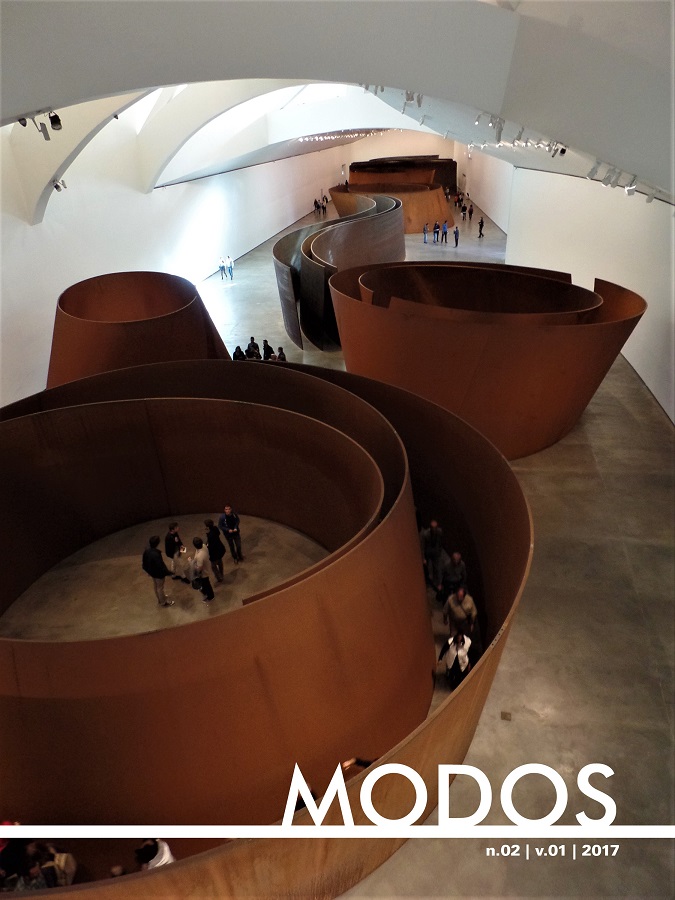Abstract
The article investigates a possible genealogy of the use of the grid system of images made by artists since the 1990s. Developed by classical visual thought, the representation grid of the visible undergoes transformations until post-Cubist artists develop an abstract modular framework, which Mondrian will, from a certain moment of his trajectory, resign in favor of the diagram. This linear history, however, is even more complex. Among the artists of the historical groups of avantguards - from constructivism to surrealism -, different modalities of multiple frames emerge out of montages of photographic images. In the 1960s and 1970s, the multiple picture resurfaces in Pop Art, being transformed by Conceptual Art and the new generation of the 1990’s. I insist on the term grid with the intentions of not accepting ideas of definitive historical ruptures, but also refusing ideas of evolution.
References
BAUDELAIRE, Charles.Critique d’art.Paris: Gallimard, ALBERRO, Alexander. Preface. “Reconsidering Conceptual Art”. 1966-1977. In: ALBERRO, Alexander. STIMSON, Blake. Conceptual art: a critical anthology. Cambridge: Massachusetts Institute of Technology, 1999.
BARRIO, Artur. Artur Barrio: A metáfora dos fluxos, 2000/1968. Rio de Janeiro: Paço das Artes, s/d.
BLANCHOT, Maurice. Duas versões do imaginário. In: O espaço Literário. Rio de Janeiro: Rocco, 1987.
BOIS, Yve-Alain. Painting as model. London, Cambridge: The MIT Press, 1995.
BUCHLOH, Benjamin; RICHTER, Gerhard. Interview with Benjamin Buchloh. In: Harrison, Charles; Wood, Paul (Org.). Art in theory: 1900-1990: an anthology of changing ideas. Oxford; Malden: Blackwell, 1992.
BUCHLOH, Benjamin. Atlas de Gerhard Richter: o arquivo anômico. Arte & Ensaios, Rio de Janeiro, n.19, p.194-209, 2009.
_____________. Atlas, Warburg’s paragon? The end of collage and photomontage in postwar Europe. In: SCHAFFNER, Ingrid; WINZEN, Mathias. Deep Storage: collecting, storing, and archiving in art. New York, Munich: Prestel-Verlag, 1998 (catálogo).
____________. From faktura to factography. October, Vol. 30, Autumn, The MIT Press, 1984.
BUREN, Daniel. Advertência. In: FERREIRA, Glória. COTRIM, Cecília. (Org.). Escritos de artista: anos 60/70. Rio de Janeiro: Zaar, 2006.
CARSON, Juli. Roberto Jacoby’s 1968: El culo te abrocho. http://uag.arts.uci.edu/sites/default/files/RobertoJacoby_0.pdf. Último acesso em 22 dez. 2016.
COSTA, Luiz Cláudio. A fábrica do sensível: as imagens contraditórias da arte. In: Vis: Revista do Programa de Pós-Graduação em Artes. V. 14, n. 2, 2016.
________________. A gravidade da imagem: arte e memória na contemporaneidade. Rio de Janeiro: Quartet, 2014
DIDI-HUBERMAN, George. Imagens, apesar de tudo. Lisboa: KKYM, 2012.
_____________. Atlas ou le gai savoir inquiet. L’oeil de l’histoire 3. Paris: Minuit, 2011.
_____________. O que vemos, o que nos olha. São Paulo: Ed. 34, 1998.
EDWARDS, Steve. Martha Rosler: The Bowery in two inadequate descriptive systems. London: Afterall, 2012.
FOSTER, HAL.O retorno do real: a vanguarda no final do século XX.São Paulo: Cosac Naify, 2014.
____________. Compulsive Beauty. Cambridge, London: The MIT Press, 1993.
FRIED, Michael. Art and objecthood. In: BATTOCK, Gregory. Minimal Art: A critical anthology. New York: E. P. Dutton & Co., Inc., 1968.
GREENBERG, Clement. Pintura modernista. In: FERREIRA, Glória. COTRIM, Cecília. (Org.). Clement Greenberg e o debate crítico. Rio de Janeiro: Zaar, 2001.
KAPROW, Allan. O legado de Jackson Pollock. In: FERREIRA, Glória. COTRIM, Cecília. (Org.). Escritos de artista: anos 60/70. Rio de Janeiro: Zaar, 2006.
KOSUTH, Joseph. Art after philosophy anda after. Collected Writings, 1966-1990. Cambridge, London: MIT Press, s/d.
KRAUSS, Rosalind. Caminhos da escultura moderna. São Paulo: Martins Fontes, 1998.
_______________. The originality of the avant-garde and other modernist myths.Cambridge, Massachusetts, MIT Press, 1994.
LEWITT, Sol. Parágrafos sobre a Arte Conceitual. In: FERREIRA, Glória. COTRIM, Cecília. (Org.). Escritos de artista: anos 60/70. Rio de Janeiro: Zaar, 2006.
LYOTARD, Jean-François. O inumano: considerações sobre o tempo. Lisboa: Estampa, 1990.
OITICICA, Hélio. Hélio Oiticica. Rio de Janeiro: Secretaria Municipal de Cultura, Projeto Hélio Oiticica, 1996. (Catálogo).
PIMENTEL, Leandro. O inventário como tática: a fotografia e a poética das coleções. Rio de Janeiro: Contra Capa, 2014.
POIVERT, Michel. L’image au service de la Révolution. Photographie, surréalisme, Politique. Le Point du Jour, 2006.
QUILES, Robert R. Dead Boars, Viruses, and Zombies: Roberto Jocoby’s Art History. http://artjournal.collegeart.org/?p=5743. Último acesso em 22 dez. 2016.
RICKEY, George. Construtivismo: origens e evolução. São Paulo: Cosac & Naify, 2002.
ROBERTS, John. Photography, iconophobia and the ruins of conceptual art. In: ROBERTS, John (Org.). The impossible document: photography and conceptual art in Britain, 1966-1976. London: Camera Work, 1997.
STELLA, Frank. JUDD, Donald. Questões para Stella e Judd. In: FERREIRA, Glória. COTRIM, Cecília. (Org.). Escritos de artista: anos 60/70. Rio de Janeiro: Zaar, 2006.
XAVIER, Ismail. Eisenstein: a construção do pensamento por imagens. In: NOVAES, Adauto. Artepensamento. São Paulo: Companhia das Letras, 1994.

This work is licensed under a Creative Commons Attribution-NonCommercial-ShareAlike 4.0 International License.
Copyright (c) 2018 MODOS

